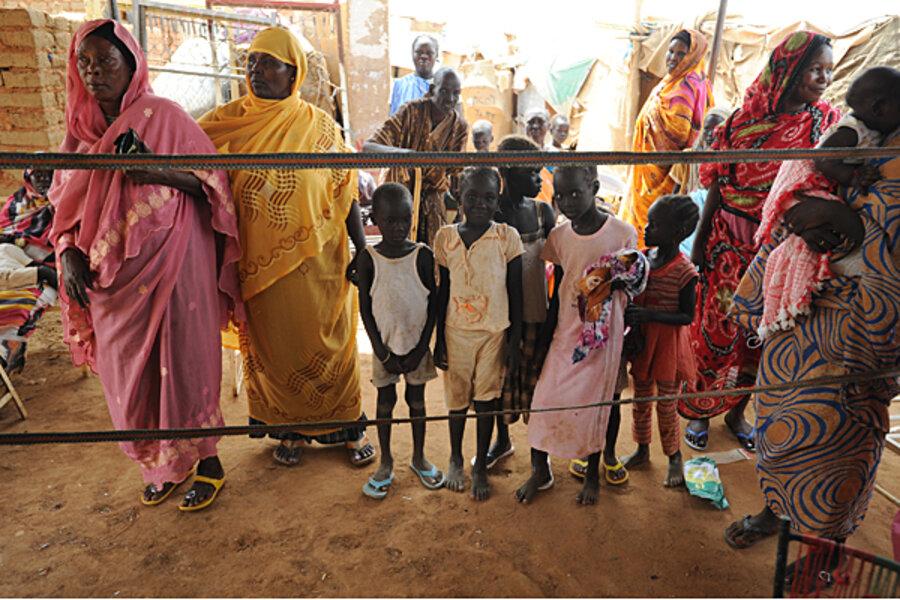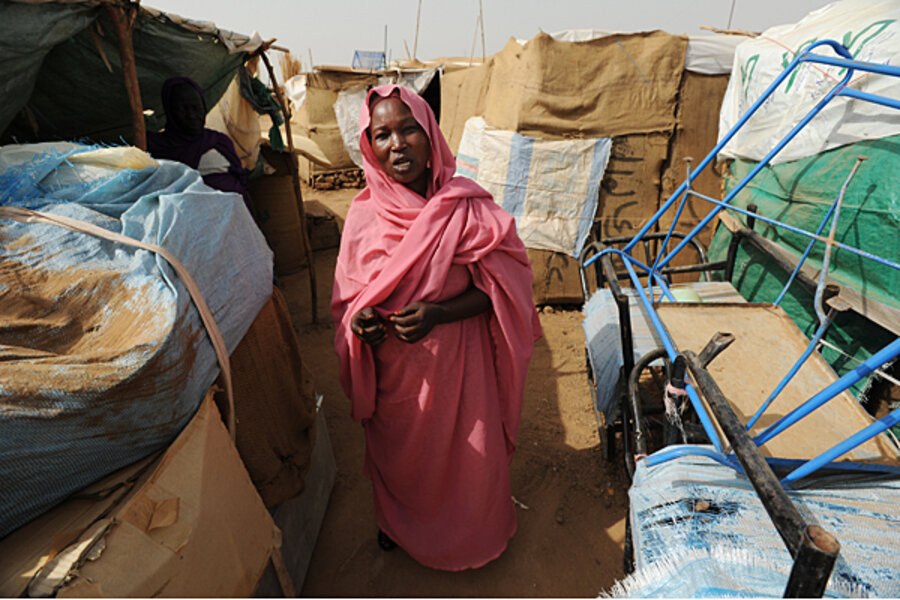A year after freedom, South Sudanese languish up north
Loading...
| KHARTOUM, SUDAN
Clustered in small enclaves on the outskirts of Khartoum, the South Sudanese families had packed all their belongings more than a year ago with high hopes of returning "home," as the newly formed nation of South Sudan was born.
After years and sometimes decades of living in Sudan's northern capital, the families wrapped metal bed frames and bales of clothes in burlap sacking, stacked high their metal chairs, and piled up suitcases in anticipation.
But then time stopped for the 350 households at this "departure point," leaving them stuck in a humanitarian limbo, taunted every day by the mountains of luggage-turned-to-walls of makeshift dwellings.
"We are selling our luggage, chairs, and beds to eat and to drink," says Martha Issa, after stepping from beneath the strung-up blanket that has sheltered her family of seven for more than a year.
"Conditions are very bad, with the mosquitoes and no water," says Ms. Issa, adjusting her head scarf to block the hard rays of a scalding sun. "They told us to come, then we never go to the south – it is up to God."
"People here lost their homes, their jobs – we lost everything," says Makarios Geitano, another member of the dusty encampment. "We just want to go back [to the south]. If we suffer, we must suffer in our own country."
These are among 38,000 people from Sudan's south who remain stuck at such sites, after waiting out the north-south civil wars that frequently tore at the country since the 1950s. Perhaps 1.5 million southern Sudanese have already left the north since peace was agreed to in 2005; no one knows how many for sure. More than 400,000 of those have left since the south voted for separation in January 2011. But those still in Khartoum who want go south languish in squalid encampments dotted on the outskirts of the capital – like this one to the east, called Dar Es Salaam – with no running water and primitive facilities, if any.
The bus that never came
The transport promised by officials from the south never came. A brief conflict this April over the Heglig oil fields polarized the two sides, with parliament in Khartoum adding to popular anger in the north by declaring the southerners in their midst citizens of an "enemy state." It also left the governments of both North and South Sudan strapped for cash after a shutdown of southern oil fields in the dispute.
Western donors have been reluctant to cover transport costs, worried that they may be abetting ethnic separatism. Those have skyrocketed with fuel prices – and questions have been raised about the ability of South Sudan to even "absorb" more of their urbanized brethren.
Moved by their plight, Mark Cutts, the head of the UN Office for the Coordination of Humanitarian Affairs (OCHA) for Sudan, hosted a meeting recently between Western donors and representatives of the south Sudanese encampments in Khartoum, who described desperation levels so high that some of the stranded were resorting to illegally brewing alcohol and prostitution to survive.
"Some donors asked: 'What if you arrive [in South Sudan] and find it is worse?' They said: 'We would rather die in the south," recalls Mr. Cutts.
UN and donor access is limited to other conflict areas in Sudan, but "here we have 40,000 people who we can help, whose case is one of great need, who feel [South Sudan] is a place where they are safe and can rebuild their lives with dignity – and the international community is afraid to be seen to facilitate ethnic separation," says Cutts.
All sides recognize that it is solely the responsibility of the two governments – especially South Sudan – to find a solution. But it has been clear for months that an official solution is unaffordable.
"What money does the government of South Sudan have? And what money does Sudan have? And if they have it, would they spend it on [people from South Sudan]?'" asks Cutts. "Even if it's a lot of money, maybe $30 million, compared to the $1.5 billion in humanitarian aid spent in a year on Sudan, north and south, it's not too much."
Blankets for roofs
In the encampments, where south Sudanese are now officially dubbed "stranded returnees," the months-long wait has added just one more strategic disappointment to lives defined by conflict, displacement and chronic uncertainty.
Children run about – one playfully taking aim at a visitor with a toy plastic gun – unable to go to school because Khartoum authorities always expected their imminent departure. Earthen ground has been swept immaculately at the refugee-style huts. Yet when it rains, water pours off the tarpaulins and through blanket "roofs," making deep muddy puddles.
"Everything is ready. If there is transport today, they will go – they will not live here one day more," says Santino Dena Mawien, a South Sudan administrative officer from Wau, as he visits this encampment. He points out the lack of any water, toilets, and baths.
"What about food? You forget?" asks Issa, the displaced mother, after overhearing the official.
"God will give it," replies Mr. Mawien, only half in jest.
"God's mercy!" answers Issa, disappointed. "They use this language to talk to us...."
Speaking later to a group of the stranded – with mothers cradling children, and most men away hunting for work or money – Mawien tries to reassure.
"If you go [back to South Sudan], there is no problem, you will go to your home, you will find your father there, your mother there, and families," says Mawien.
That prospect certainly appeals here. The "souk" in the encampment has an assortment of goods at fire-sale prices: a BBQ set-up, an aged Singer sewing machine, a satellite dish, a gallon of synthetic enamel paint and a clothes iron – all for sale so those stuck here have money to buy food.
Inside one shelter, an baby sweats on a bed, asleep. In another, an unwell man lays sprawled in the sweltering heat.
"There is no hope," says Illario Upiou, at the group meeting. "Nobody told us anything."
That sentiment is helping drive the new effort to get these South Sudanese back to their areas, even though estimates of the total number of southerners still in the north sometimes top 170,000 – but could actually be half that.
'No operational plan'
Though hundreds of thousands already went south, the government ran out of money earlier this year, says Jill Helke, the chief of mission for the International Organization for Migration (IOM) in Sudan.
"If you ask people if they want to go back [to the south], the answer depends on who is asking, and perceptions of the options," says Ms. Helke. "Now there is no operational plan, still no idea how many southern Sudanese there, are and who wants to stay."
Earlier this year, IOM moved 500 people south on two trains. And this spring, after fighting made barge movement too tricky and roads unsafe, the IOM moved 12,000 people from a way station at Kosti – built to house just one-tenth that number – first by road back up north to Khartoum, then south by air.
The 10-day Heglig conflict in April brought "hateful stuff" about southerners, from northern politicians and the media, ridiculing "enemies, cockroaches, aliens, so even those [southerners] who wanted to stay might have second thoughts," says Helke.
"Donors had their fill from the very beginning, because both governments have taken no responsibility whatsoever," adds Helke. "For the last year, donors say the situation is not enough of an emergency. And still the problem is that South Sudan is such a mess, they ask how can we send people back there, only to look after them there?"
Welcome to the jungle
South Sudanese who have spent years in the north are sometimes "regarded as outsiders" in the south, where "absorption capacity is zero," notes Helke. Some 1,130 people still remain in a transit camp in the southern capital of Juba, and transitions have not been easy.
"People arrive after 20 years [in the north]. They are urbanized, but outside of Juba it is jungle," says a UN humanitarian source who asked not to be named. "They are shellshocked, and told: 'Here's your $10 and your place 150kms [93 miles] away.' In most areas there is no infrastructure; 90 percent of health and education is handled by NGOs [nongovernmental organizations]. And since 2005, $4 billion has gone missing."
But the risks of staying on in the north are also high, as the economy deteriorates and north-south tensions are easily fanned.
"Southerners don't feel secure here, and the sooner they begin their lives in the south, the better," says the UN official. "We are now at the juncture, and I think donors need to rethink" their reluctance to fund the return.
In recent weeks, the South Sudan Relief and Rehabilitation Commission said it would truck to the south these 40,000 "stranded" around Khartoum.
"So far nothing has been forthcoming," says the UN official, "except for this soundbite."
Follow Scott Peterson on Twitter @peterson_scott








